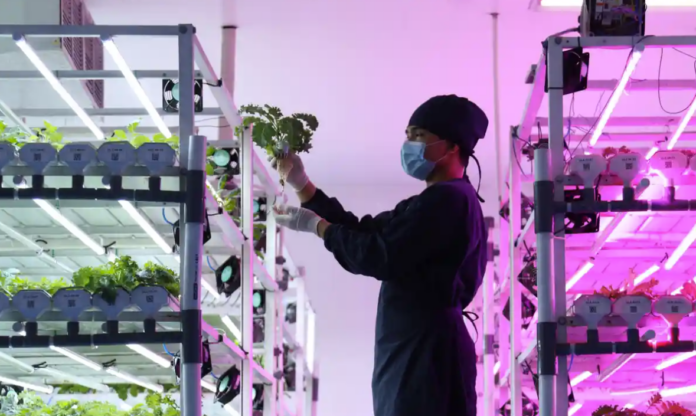[Photo:A vertical farm in west Java, Indonesia. Photograph: Dasril Roszandi/NurPhoto/REX/Shutterstock]
Article posted 8/21/22
Behind an airtight door, inside a warehouse 10 minutes walk from Bristol city center, shelves of vibrant chives sprout enthusiastically towards a sky of multicolored LEDs. The air they are transpiring smells earthy, despite the absence of soil, while a mechanical hum provides a soothing substitute for birdsong.
Welcome to the future of farming, where herbs, salads and soft fruits are grown year-round, in vast, indoor plant factories.
In June, the British vertical farming startup the Jones Food Company (JFCo), announced it was building the world’s largest vertical farm on the site of an old forge in Lydney, Gloucestershire.
Its CEO, James Lloyd-Jones, predicts that within 10 years the UK could be growing all its herbs, salad leaves, soft fruits – and potentially cut flowers – this way: “Vertical farms will become the norm within the supply chain, and probably take away greenhouse production and imports.”
The seeds of this revolution are being sown – in vertically stacked layers of sheep’s wool – at JFCo’s innovation centre in Bristol. Lloyd-Jones said: “Vertical farming can grow anything. It just grows lots of things too expensively to be commercially viable, so here is where we are learning how to commercialise it.”
In the first of four 69 sq. meter grow rooms are stacks of brilliant green chives. Every environmental parameter in the room is tightly controlled, from the temperature, humidity and carbon dioxide content of the room, to the color spectrum, intensity and pattern of the light-dark cycle, and the nutrients the seedlings are exposed to.
Farming this way could have numerous advantages. “One of the big benefits is that we’re growing in a way that doesn’t impact on nature,” said Charlie Guy, cofounder of LettUs Grow, a Bristol-based company that’s developing technology for vertical farms.
“It also means we can focus more of our land on things like tree planting. So, from a biodiversity standpoint, there are massive benefits.”
Analysis
I chose this article because I think vertical farms are a really interesting idea when it comes to food production, supply chain, and business. It is not as conventional as the typical way of farming, but makes a lot of sense when you consider all the space saved. There are a variety of complications with vertical farming currently, however I believe there is room for design to improve what has been tried in vertical farming to make it a profitable business strategy for farmers.
Take-aways
Design and additive manufacturing can consider how to capitalize on vertical space – land and space are expensive so utilizing vertical space is cost effective and debatably more efficient




